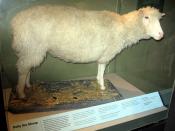Cloning is the production of a group of genetically identical cells or
organisms, all descended from a single individual. The members of a clone
have precisely the same characteristics, except where mutation and
environmentally caused developmental variation have occurred. The DNA is
precisley the same and they are only differentiated by their experiences in
which dictate their personality. There are some types of natural cloning
that nature displays. Some animals have tremendous powers of Regeneration.
If the body of certain starfishes is cut up into its five arms, each arm
will regenerate a complete individual. Another type of asexual reproduction
found in all animals, human beings included, is the formation of identical
twins, triplets, and so on. Identical siblings constitute a clone. The
growth of a tumor in the body of an individual is, in effect, the formation
of a clone of malignant cells. Humans have learned from nature and started
their cloning saga also.
In one method of artificial cloning used in plant
breeding, cells are cut from a plant and placed in a flask with a nutrient
medium. The cells grow and divide, forming embryonic tissues that are
transferred to soil, where they produce complete plants. Grafting is
another method of cloning used in Horticulture. Matching cuts are made in
the stems of two plants, which are then fitted together so that their
transport systems are in contact. The wounded area heals, and the two stems
become a single physiological unit. All the McIntosh apple trees now in use
and many other fruit varieties have been derived by grafting from single
ancestral trees. "Nuclear transplantation," in which nuclei from cells of
one individual are transferred to unfertilized eggs whose nuclei have been
removed, is one method of artificial cloning in animals. All the
transplanted nuclei are generally identical,


